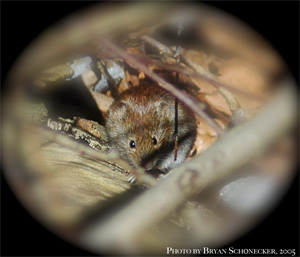The European Bank Vole as Experimental Animal
|
|
||
| Biology | ||
| Zoonoses | ||
| Capture and Maintenance | ||
***
|
||
| Behaviour in Captivity | ||
| Introduction to Stereotypic Behaviour | ||
| Stereotypic behaviour among bank voles | ||
*** |
||
| Chronology regarding animal model potentials | ||
| Potential animal model for Type 1 and 2 diabetes | ||
| Potential animal model for Depression and Anxiety | ||
| Potential animal model for seizures | ||
| Related patents / patent applications | ||
*** |
||
| Past/Present uses in research | ||
*** |
||
| References and links | ||
| Pictures of Bank voles | ||
*** Most of the above-mentioned chapters, in addition to selected chapters/excerpts from my 2012 PhD dissertation, have now been used as basis for the following five books. They are all primarily intended as an aid for advanced students of biology and medicine and are available in PDF and EPUB versions through www.saxo.com
"The bank vole as experimental animal" and "Student's guide to Diabetes" both represents the "state of the art" within their respective fields, and both these books can also be of considerable interest to seasoned researchers interested in a broad and thorough overview of these subjects. The book addressing bank voles also includes a most practical chapter in relation to ethical considerations (a "must-know" if you intend to submit own manuscripts involving animal experiments). My guide to diabetes will presumably also make it more easy for you to control your natural enthusiasm the next time you hear or read about a new "major breakthrough" in relation to these diseases. My "Student's guide to Epilepsy" highlights the many severe complications which are so commonly downplayed. Fact of the matter is that the epilepsies are still a mystery and that progress within this field is very slow. The best drugs of today are not much better than the drugs used a century ago, and researchers haven't even reached a consensus regarding how to define seizures, fits, attacks, etc. Faulty diagnoses are also rather common, but the bright side is that many patients eventually stop experiencing seizures, even without treatment. You will find the same problem in how to define the basics in my "Student's guide to Animal Stereotypies" which is a brief summary based on 15 years of experience as an intermittent researcher and eager consumer of the literature in this miniscule field. Here the problem obviously resides within the fact that so few researchers are interested in making an "experimental difference", the bright side being that it should be fairly easy for the novice to set-up new pioneering experiments. My "Student's guide to Animal Models" is intended to be a basic and no-nonsense introduction to the use of animals as research subjects and means to an end. What you will find here is factual information and no disturbing pictures of little puppies or monkeys with shaved heads and metal spikes sticking out.
plingohuttest plyttelyt |
||
